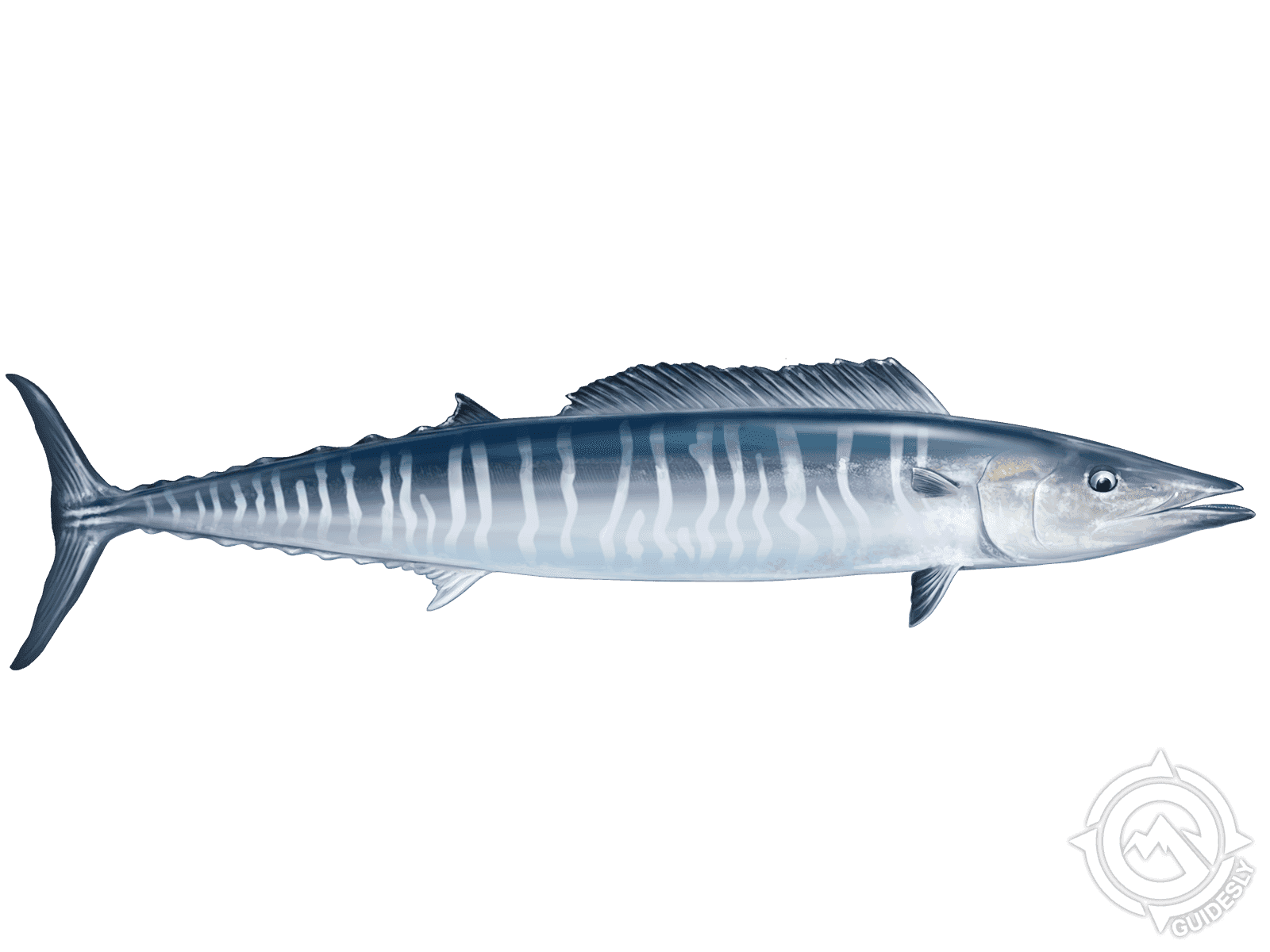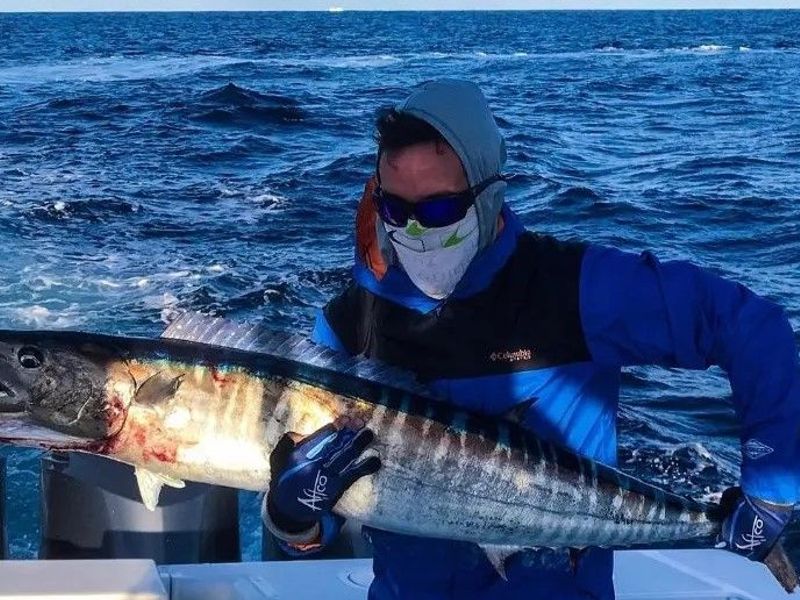Wahoo Fish

Species Details
Acanthocybium Solandri
Scombridae
Perciformes
Nearshore, Offshore, Reef
15 - 184 lbs.
8" - 100"
What is a Wahoo Fish?
The Wahoo, also known as Ono, is a large game fish found on the Gulf of Mexico and Atlantic Ocean coastlines of the United States. Learn about fishing techniques, habitat and seasonality at Guidesly!
Wahoo (Acanthocybium Solandri) Fish Description
The wahoo has a slender, elongated body covered with small scales. It has a shimmering blue back that may appear green from above and has silvery sides with zebra-like blue stripes or bars. Its underside is silvery-white.
It has a beak-like snout, large mouth, and sharp serrated teeth. The wahoo has a fold of skin that covers its jaw when the mouth is closed which differentiates it from the Spanish mackerel and Atlantic mackerel.
It has 2 dorsal fins that trail off into 8-9 finlets, leading to a forked caudal fin. The anal fin is aligned below the second dorsal fin and has 9 finlets. Its lateral line stretches across its entire body and curves under the first dorsal fin.
Spawning
The Wahoo reproduces through broadcast spawning, where females release eggs simultaneously that males discharge sperm. This increases the chances of fertilization and lessens the odds of the eggs being consumed. Adults reproduce multiple times within the year-round spawning season, usually near Florida and the Caribbean. Females can produce several million eggs a year, and this high reproductive rate and accelerated growth have kept this fish safe from overfishing.
Size and Speed

The Wahoo grows fast and is generally 3 to 5 feet, but has been documented at 8 feet 2 inches. The IGFA All-Tackle world record is at 184 lb caught in Mexico in 2005.
It’s one of the fastest fish with an average speed of 48 mph and a top speed of up to 60 mph. Their spindle-shaped body and endurance make them successful hunters.
Interesting facts about the Wahoo
- Ono, another name for the Wahoo, means “good to eat” or “delicious” in Hawaiian
- Its colors fade immediately upon death
- It is unable to regulate its body temperature
- It is prey only to the largest ocean predators, such as sharks and billfishes
- The Wahoo’s speed makes it a prized game fish similar to barracuda. It’s also coveted for its delicate flaky flesh, making it a premium-priced food fish.
Diet
This large fish has a very diverse diet that consists of squid, tuna, little tunny, porcupine fish, flying fish, dolphinfish, jacks, herring, pilchards, scad, frigate mackerel, butterfish, and lantern fish, as well as many other pelagic species.
Is Wahoo Good to Eat?
Wahoo fish is a popular game fish found in the warm waters of the Atlantic, Indian, and Pacific Oceans. This species is known by names such as Ono in Hawaii and Peto or Beto in Mexico. The question that arises for most people is whether Wahoo Fish makes for a good meal or not.
Wahoo has a firm texture with white meat that's mild and sweet tasting. It's often compared to other pelagic fishes like tuna, swordfish, and mahi-mahi due to its delicate flavor. Wahoo also has low oil content making it ideal for those who prefer less oily seafood. This fish is well known for Wahoo fish tacos. Wahoo is a healthy, extra-lean protein, low in saturated fat and sodium. Wahoo is rich in omega 3's, niacin, vitamin B6, vitamin B12, and other nutrients.
When cooked properly, wahoo can be an exceptional food item that satisfies even the most discerning palates.
Fishing Techniques: How to Catch a Wahoo
In the Gulf of Mexico, the Wahoo doesn’t stray far from the shore. They can be found near oil and gas platforms, particularly near Port Aransas in Texas. The angler will have success here especially during the cooler months. They are abundant in Florida from July to November and fishing Wahoo peaks in Hawaii from May to October. However, you may find the best place for Wahoo fishing is in their native Bahamas when they are migrating in high numbers between March and November.
High-speed trolling at 12-15 knots with a 4-6 lure spread is commonly used to catch this fish. A fast trolling rig will feature a 30-50 wide reel with wire leaders since the wahoo’s teeth can cut through mono or fluorocarbon easily. Anglers can use a double braided line attached to an 80-100lb leader about two feet long. Minnow lures, bulletheads, and plungers are some favorite lures to use.
If slow trolling (around 8-10 knots), fresh ballyhoo baited on double J-hooks with a rubber skirted resin head lure, or a diving-lipped lure is effective. Using jigs under floating debris and chunking are also efficient fishing techniques.
Habitat & Distribution

The Wahoo is found in all tropical and subtropical waters worldwide but may migrate to higher latitudes during warmer months. Its native range includes the Atlantic, Indian, and Pacific Oceans.
In the north Atlantic, it’s abundant during the summer from North Carolina and Bermuda and year-round in Florida to the Gulf of Mexico.
The Wahoo is a pelagic open-ocean fish that is often drawn toward drifting objects is commonly found in waters up to 66 feet deep. While it’s known for being solitary, it may form small groups of 2-3 individuals and will form larger groups when mating.







